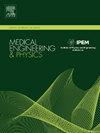Utilization of skin color change for image-based tactile sensing
IF 2.3
4区 医学
Q3 ENGINEERING, BIOMEDICAL
引用次数: 0
Abstract
Measurement of pressure distribution applied to a fingertip is crucial for the teleoperation of robots and human computer interface. Previous studies have acquired pressure distribution by affixing a sensor array to the fingertip or by optically recording the deformation of an object. However, these existing methods inhibit the fingertip from directly contacting the texture, and the pressure applied to the fingertip is measured indirectly. In this study, we propose a method to measure pressure distribution by directly touching a transparent object, focusing on the change in skin color induced by the applied pressure, caused by blood flow. We evaluated the relationship between pressure and skin color change when local pressure is applied, and found a correlation between the pressure and the color change. However, the contact area and the color change area did not align perfectly. We further explored the factor causing the spatial non-uniformity of the color change, by accounting for the stress distribution using finite element analysis. These results suggest that the proposed measurement method can be utilized to measure the internal stress distribution, and it is anticipated to serve as a simple sensor in the field of human computer interface.
肤色变化在基于图像的触觉感知中的应用
指尖压力分布的测量是机器人远程操作和人机界面的关键。以前的研究通过在指尖上安装传感器阵列或通过光学记录物体的变形来获得压力分布。然而,这些现有的方法抑制了指尖与纹理的直接接触,并且间接测量了施加在指尖上的压力。在这项研究中,我们提出了一种通过直接接触透明物体来测量压力分布的方法,重点关注由血液流动引起的施加压力引起的皮肤颜色变化。我们评估了局部施加压力时压力与皮肤颜色变化之间的关系,并发现压力与颜色变化之间存在相关性。然而,接触区域和颜色变化区域没有完全对齐。通过有限元分析计算应力分布,进一步探讨了引起颜色变化空间不均匀性的因素。这些结果表明,该测量方法可以用于测量内应力分布,有望成为人机界面领域的简单传感器。
本文章由计算机程序翻译,如有差异,请以英文原文为准。
求助全文
约1分钟内获得全文
求助全文
来源期刊

Medical Engineering & Physics
工程技术-工程:生物医学
CiteScore
4.30
自引率
4.50%
发文量
172
审稿时长
3.0 months
期刊介绍:
Medical Engineering & Physics provides a forum for the publication of the latest developments in biomedical engineering, and reflects the essential multidisciplinary nature of the subject. The journal publishes in-depth critical reviews, scientific papers and technical notes. Our focus encompasses the application of the basic principles of physics and engineering to the development of medical devices and technology, with the ultimate aim of producing improvements in the quality of health care.Topics covered include biomechanics, biomaterials, mechanobiology, rehabilitation engineering, biomedical signal processing and medical device development. Medical Engineering & Physics aims to keep both engineers and clinicians abreast of the latest applications of technology to health care.
 求助内容:
求助内容: 应助结果提醒方式:
应助结果提醒方式:


